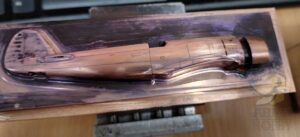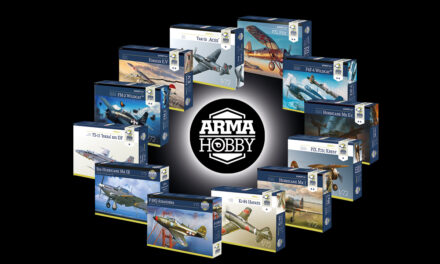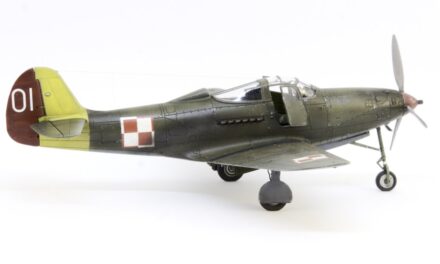Meet Maciej “Wrona” Wroński, designer of the newest Arma Hobby kit, the 1/72 Ki 84 Hayate. Earlier Maciej has designed a 1/72 and 1/48 scale line of the PZL fighters prototypes in resin and 1/48 resin Grumman F2F – winner of the Nurnberg Fair “Model of the Year 2016” Medal awarded by the German “Modell Fan” Monthly.
Read the interview in which “Wrona” reveals model kits designing secrets, tells the story of his career and shares his unusual passion: recyclable sailing boats which he scratchbuilds ‘from nothing’ and uses to sail on the wild lakes of northeastern Poland.
Grzegorz Mazurowski: How did you get to Arma Hobby?
Maciej „Wrona” Wroński: It was when I decided to deal with 3D design. Before I did various things. As a kid, I was fascinated by motorbikes, I wanted to be a mechanic, but my parents advised against it. So it happened that I graduated from the Art High School in Warsaw, it was a fantastic school. Not only because we did cool things, but I also met cool people there. People with passion, people who have their own interests and opinions. The school gave me some professional skills, we learned a lot, from painting, sculpture, drawing, through design, photography to technical drawing, really a lot. And this allows me to feel at ease as a designer today. Of course, later there was also the Warsaw Academy of Fine Arts, where I studied design and met Marcin Ciepierski, who, together with Wojtek Bułhak, is the founder and owner of the Arma Hobby. The Academy is very good school too, lots of interesting things. I have been doing various things professionally, in Poland and abroad, but finally I thought to come back to design because it is interesting. And the first thing I did was call Marcin because I knew he was designing, he was a person worth asking for advice, and he immediately let me in the Rhino, a good 3D program, said: learn the Rhino. And then he offered me an internship at Arma Hobby.
And that’s how it all started?
We both didn’t know what would come of it, but there was good will to do something together and we got on well then. I was eager to train some more… And at Berneńska Street, in the first Army headquarters, we started making resin model kits. It was my first episode with Arma Hobby, I worked there for a year and a half and I remember it as a very good time. Then the resin projects were abandoned, I went to the UK, and after a few years in Wales, when I returned to Poland in 2020, I also returned to the Arma Hobby and now we are making plastic models together.
PZL prototype kit 1/48 design, resin kit from Arma Hobby.
What exactly did you do in this first period?
I designed, everything. Kit 3D parts, PE details, decals, instructions, totally. Designing the entire model. Also renders for advertising purposes. I just didn’t make boxes. Only now do I only do 3D and I am happy about it. Because there is a lot to be done anyway, this job is interesting and I feel good in this 3D that I can focus on it. When you open Rhino, you know that you have to design an aeroplane or an aeroplane part, you have to search through these photos, plans, it takes a lot of time to find sources, make a sketch, to create a 3D model from it. You need a lot of time to find the source and transform it into a specific model.
What project did you start with?
Unfortunately, we were not allowed to release my first project due to problems with obtaining a license from the original manufacturer. Legal issues are serious things and we always make sure that everything is fulfilled. Then there were prototypes of Polish PZL pre-war fighters. PZL P.6, in my opinion, was the prettiest of them. And I did Grumman in both scales, 1/72 and 1/48. And some bombs, missiles.
The Grumman that got the “Model of the Year” medal from Modell Fan?
Yes. Model of the Year 2016, Grumman F2F. I designed it almost completely, Marcin had this project started a bit, and he handed it over to me. I designed the entire model kit. Except for the box. In 2014-15 I had the opportunity to design all these elements, 3D prints that were later copied in the resin, and decals, instructions, photo-etched parts, some masks, everything. The model kit is a complete thing.
So – you design a model kit and it gets a medal, international recognition?
It turns out you can do something really good. It is powerful. It’s not really about some profit. It’s just about – with my ‘mileage’, with all my complicated CV…
…with your sailing boat made of rubbish…
Yes! And with all the work that I did before. And here I come back to designing and I have great satisfaction. Like few else I can tell myself that I can do it. Because I have done so many different things and have so many experiences and references. Now I come to work and design another toy, and then the Germans give me a medal at the Nuremberg Fair, the Japanese are interested in our work and do an interview, that’s good. But I am concerned primarily with the design itself. This is an exquisite profession, it requires skill. And it turns out that for years I collected these skills in an art school, the Academy, or in other places, doing something, even being interested in ordinary motorcycles, building boats out of nothing. I see that this also translates into some idea about these airplanes, their design.
And your boats?
Design haunts my whole life. In 2011 I decided to scratch build a real little sailboat, and then people wondered why I threw it away after a month. And what I really wanted was to find out, to prove something. To make such an event – to make the boat from what I had access to. I never use standard technological solutions, this is just an element of design for me, that I take what is available and try to make a toy for the season.
And what “is available”? A bathtub?
Noooo, making a boat out of a bathtub or plastic bottles is not for me, because it is boring, it does not demand invention. In 2011, there was a sheet of polystyrene, I was working at an exhibition at the moment and such stuff was left. This was the base for making the hulls. It worked out great. In 2012 I went crazy and made a boat out of galvanized steel sheets and some aluminum profiles, I had a great time doing it, but it turned out that I didn’t really like it. Metal is grateful medium, but it is not suitable for a small boat, on which you run barefoot, it turns out that the metal part will bear the load well, but it is so thin, narrow that it is impossible to walk on it comfortably, you can bruise yourself, hurt yourself. Wood is different, the cross-sections of wooden elements are so wide that they fit well in the hand, you can walk on them nicely, the wood heats up less in the sun, does not burn, such non-obvious things are of great importance.
It’s very interesting!
This is very important in the process of using such a thing. You also had to experience this to realize it. I’m not an engineer, but I make these boats, from sticks or something else, and I watch the boats sail. This, too, is an experience. How things work.
In 2013, I decided to make a very small double-hull sailboat out of waste. A friend was building a house and there were remains of polystyrene, from work I took the remains of the packaging foil, found some more sticks, some spare string – literally! It was a challenge to make it literally out of nothing and for pennies. And it sailed! And after the holidays, I sorted and disposed of everything according to the rules, because I did not plan to keep it for posterity, because that was not what it was about.
What it was about?
Two things: the design and construction itself, but also the fact that I did not have a sailor’s license, so no one wanted to rent me a boat, so I made a boat myself. What a pleasure it was as it turned out that such a real yaht isn’t faster than me…
Was your boat faster than the real yaht?
Maybe not faster, but there was no shame as I had it made of rubbish. I sailed around Wigry lake, it was my summer toy, it met my expectations. It could be folded, unfolded, put on the roof of the car, compactly packed, the small hull fit in the large fuselage for transport. It was a process of design, manufacture and use. It has been carried out. And those boats that I made were boats from which 99% of people laugh, because they see the garbage from which I made them, scrap, but with this one percent of people … I tell you honestly, I even make movies, document this process, I post it on YouTube, and I have to tell you that interesting people from the other side of the world speak up. These people appreciate it, they say that they haven’t seen something like this, that it floats well.
Elektrody do formy Ki-84
What’s your latest project?
Ki-84 Hayate in 1/72 scale, but only 3D design, all what is needed to make injection moulds to produce models kit sprues in them.
Do you think more about the aeroplane whose model kit you are designing, or about a plastic sprue with parts, or finally about a metal mould from which the sprues come out?
It depends a bit on the stage. I need to think about this plane all the time because it’s supposed to be a model kit of this plane, but at some point we move on to the next stage of design, although these stages overlap, because when you start, it’s good to think about the moment when you finish. The awareness of what the final effect should be grows with the project, it grows, but … I think about all the photos that I have provided, plans…
Of the aeroplane you’re designing?
Yes, there is also some knowledge, theory, and in the meantime, I’m starting to think about technology to turn it into a plastic model kit. It is a long way to turn it into a model kit that hits the market. I am surprised how long it is.
How long?
Well … long. Designing itself – you can say a few months non-stop, of course, depending on the blueprints, better-worse, older-newer, the quantity and quality of the photos, drawings. Depends on how the sources describe this object. There were not many blueprints for PZL fighters prototypes, there are many for Hayate. But without a few months of hard work it is impossible to make a reliable 3D model in 1/72 or 1/48 scale. And then there’s the implementation process, too, it turns out, quite long.
What is your priority?
When the basic 3D shape is ready, it seems that everything is designed, just make a mould and inject plastic, but then you have to look at it all over again, all these photos, follow how these panel lines goes, count these rivets, find all irregularities in them, such tastes, flavours, this is the stage at which rescaling is so dirty as everything it cannot be fully reproduced directly in the scale. You have to use some kind of convention. And here you need to stop and think about it, make it look decent, make the model kit cool.
Well, because this is a question that is constantly discussed on modelling forums, whether to rivet the model kit or not, whether the designer should take care of it or leave it to the modeller.
I’m not surprised. This is a matter of convention. You need to make a model kit that looks very good just taken out of the box and assembled, but also gives some opportunity to the advanced modeller to show off. For someone who wants to spend more time, who has the skills and experience, it is worth leaving some space to show off. Let it be a sport for everyone. Especially since we, if we deal with mass production, we cannot deal with everything at once, it simply will not work, because there are different expectations. The most valuable thing is to fit well. Not to forget about novice modelers and also remember about those who can do more.
How would you describe the perfect model kit, not the super advanced one, but the optimal one?
From my point of view, a well-designed model kit is when I do not see any further possibility of squeezing something more out of the technology we operate. When I squeezed everything out of the technology, I came up with a way to divide and assemble this model kit in order to describe as much of this aeroplane as possible with the most reasonable number of parts and making these parts as simple as possible. Then I feel like I did it right. If I finish the project so that the guys in the tool shop do not think about it at all, but do it, I feel that I did it right.
When it comes to model kits – I have a professional passion for them. If it sells well, if I can design a model kit that has a plastic sprue and transparencies in the box, and no photo-etched details are needed, nothing else, and it’s good, then it’s a work of art to me. A model kit that does not have a PE details, but is just as good as if it had a PE. That it was made from one injection, and yet it is a finished model kit, you do not need to buy anything for it. It is a satisfaction for me that I have done something reasonable.
See also:
Modeller, son and father of a modeller. Loves digging through references and analysing old photographs. He builds aircraft, ship and vehicle models, the older the better. He has a weakness for Polish equipment, but does not despise the RAF, FAA and Great War topics. A journalist by training.
This post is also available in:
 polski
polski











